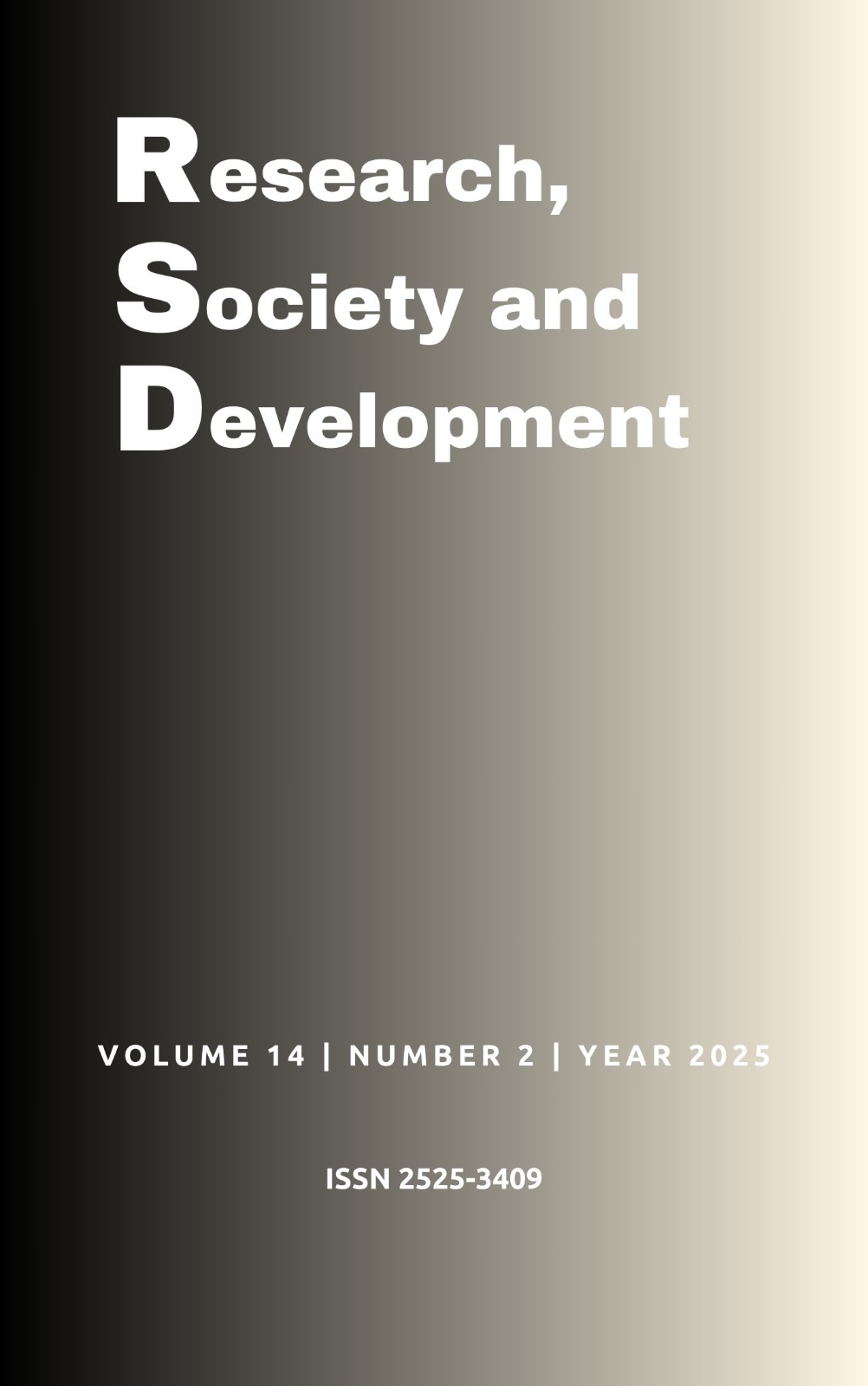Os efeitos terapêuticos e aplicabilidade do uso de Canabidiol em pacientes portadores da doença de Alzheimer
DOI:
https://doi.org/10.33448/rsd-v14i2.48329Palavras-chave:
Cannabidiol, Alzheimer, Terapêutica.Resumo
A Cannabis tem sido estudada por seu potencial terapêutico, especialmente no tratamento de doenças neurodegenerativas como Alzheimer, devido aos efeitos neuroprotetores, anti-inflamatórios e antioxidantes dos canabinoides. O sistema endocanabinoide, que inclui os receptores CB1 e CB2, desempenha papel crucial na regulação de funções fisiológicas e comportamentais. O objetivo desta pesquisa é entender melhor a capacidade dos canabinoides de modular essa via excitotóxica, posicionando-os como potenciais agentes terapêuticos que podem oferecer proteção contra os efeitos degenerativos da DA. A revisão seguiu a resolução ética n°466/2012, utilizando dados de domínio público e foi realizada nas bases MEDLINE/PubMed entre janeiro e março de 2024. Foram selecionados 52 artigos, dos quais 5 atendiam aos critérios de inclusão, com foco em estudos publicados entre 2018 e 2024. Esses estudos indicaram que o CBD tem impacto positivo no tratamento da doença, ajudando a modular mecanismos patológicos e melhorando sintomas cognitivos e neuropsiquiátricos. Entre as abordagens estudadas, a cannabis foi eficaz no alívio de sintomas como agitação e distúrbios comportamentais, além de benefícios na rigidez e nos escores cognitivos. O CBD mostrou efeitos protetores contra o estresse oxidativo, e a modelagem molecular sugeriu que compostos da Cannabis sativa podem interagir com alvos terapêuticos da doença de Alzheimer. Apesar dos resultados positivos, a revisão destaca a necessidade de mais pesquisas e superação de barreiras legais para garantir a eficácia e segurança da cannabis medicinal no tratamento da Alzheimer.
Referências
Abate, G., Uberti, D., & Tambaro, S. (2021). Potential and limits of cannabinoids in Alzheimer’s disease therapy. Biology, 10(6), 542. https://doi.org/10.3390/biology10060542
Antonsdottir, I. M., Makino, K. M., & Porsteinsson, A. P. (2016). Dazed and confused: Medical cannabis in Alzheimer disease. The American Journal of Geriatric Psychiatry, 24(11), 1004–1006. https://doi.org/10.1016/j.jagp.2016.07.004
Bahji, A., et al. (2019). Cannabinoids for the neuropsychiatric symptoms of dementia: A systematic review and meta-analysis. The Canadian Journal of Psychiatry, 65(6). https://doi.org/10.1177/0706743719892717
Barbosa, A., et al. (2020). O uso do composto de Canabidiol no tratamento da doença de Alzheimer (revisão da literatura). Research, Society and Development, 9(8), e442986073. https://rsdjournal.org/index.php/rsd/article/download/6073/5023/27743
Bastos, M., et al. (2023). Factors associated with Alzheimer’s disease prevalence and mortality in Brazil – An ecological study. PLOS One, 18(8), e0283936. https://doi.org/10.1371/journal.pone.0283936
Bhunia, S., et al. (2022). Cannabidiol for neurodegenerative disorders: A comprehensive review. Frontiers in Pharmacology, 13, 989717. https://doi.org/10.3389/fphar.2022.989717
Bonini, S. A., et al. (2018). Cannabis sativa: A comprehensive ethnopharmacological review of a medicinal plant with a long history. Journal of Ethnopharmacology, 227, 300–315. https://doi.org/10.1016/j.jep.2018.09.013
Casarin, S. T. et al. (2020). Tipos de revisão de literatura: considerações das editoras do Journal of Nursing and Health. Journal of Nursing and Health. 10 (5). https://periodicos.ufpel.edu.br/index.php/enfermagem/article/view/19924.
Cheng, D., et al. (2014). Chronic cannabidiol treatment improves social and object recognition in double transgenic APPswe/PS1ΔE9 mice. Psychopharmacology, 231(15), 3009–3017. https://doi.org/10.1007/s00213-014-3583-x
Coles, M., et al. (2020). Medium-dose chronic cannabidiol treatment reverses object recognition memory deficits of APPswe/PS1ΔE9 transgenic female mice. Frontiers in Pharmacology, 11, 587604. https://doi.org/10.3389/fphar.2020.587604
Coory, R., Gupta, V., & Suphioglu, C. (2020). Current aspects of the endocannabinoid system and targeted THC and CBD phytocannabinoids as potential therapeutics for Parkinson’s and Alzheimer’s diseases: A review. Molecular Neurobiology, 57(11), 4878–4890. https://doi.org/10.1007/s12035-020-02175-3
Elsohly, M. A., et al. (2017). Phytochemistry of Cannabis sativa L. In A. D. Kinghorn, et al. (Eds.), Phytocannabinoids (pp. 1-36). Springer International Publishing. https://doi.org/10.1007/978-3-319-44756-0_1
Henriques, J. (2023). Cannabis and cannabinoids’ therapeutic applications and safety – a literature review. Repositório Aberto. https://repositorio-aberto.up.pt/bitstream/10216/121337/2/343772.pdf
Li, S., et al. (2023). Impact of the cannabinoid system in Alzheimer’s disease. Current Neuropharmacology, 21(3), 715–726. https://doi.org/10.2174/1570159X20666230317142138
Patil, N., et al. (2023). Investigation of Cannabis sativa phytochemicals as anti-Alzheimer’s agents: An in silico study. Plants, 12(3), 510. https://doi.org/10.3390/plants12030510
Paschalidis, M., et al. (2023). Tendência de mortalidade por doença de Alzheimer no Brasil, 2000 a 2019. Epidemiologia e Serviços de Saúde, 32(2), e2022886. https://doi.org/10.1590/S2237-96222023000200002
Peprah, K., & McCormack, S. (2019). Medical cannabis for the treatment of dementia: A review of clinical effectiveness and guidelines. Canadian Agency for Drugs and Technologies in Health.
Pereira A. S. et al. (2018). Metodologia da pesquisa científica. [free e-book]. Santa Maria/RS. Ed. UAB/NTE/UFSM. Rother, E. T. (2007). Revisão sistemática x revisão narrativa. Acta Paul. Enferm. 20 (2). https://doi.org/10.1590/S0103-21002007000200001.
Watt, G., & Karl, T. (2017). In vivo evidence for therapeutic properties of cannabidiol (CBD) for Alzheimer’s disease. Frontiers in Pharmacology, 8, 106. https://doi.org/10.3389/fphar.2017.00106
Downloads
Publicado
Edição
Seção
Licença
Copyright (c) 2025 Fernanda Silva Coutinho; Eduardo Chaves Ferreira Coelho; Taís Garcia Rocha; Danilo Borges de Sousa; Ricardo Silva Freire ; Gabriel Cerqueira Santos; Graziela Torres Blanch

Este trabalho está licenciado sob uma licença Creative Commons Attribution 4.0 International License.
Autores que publicam nesta revista concordam com os seguintes termos:
1) Autores mantém os direitos autorais e concedem à revista o direito de primeira publicação, com o trabalho simultaneamente licenciado sob a Licença Creative Commons Attribution que permite o compartilhamento do trabalho com reconhecimento da autoria e publicação inicial nesta revista.
2) Autores têm autorização para assumir contratos adicionais separadamente, para distribuição não-exclusiva da versão do trabalho publicada nesta revista (ex.: publicar em repositório institucional ou como capítulo de livro), com reconhecimento de autoria e publicação inicial nesta revista.
3) Autores têm permissão e são estimulados a publicar e distribuir seu trabalho online (ex.: em repositórios institucionais ou na sua página pessoal) a qualquer ponto antes ou durante o processo editorial, já que isso pode gerar alterações produtivas, bem como aumentar o impacto e a citação do trabalho publicado.


